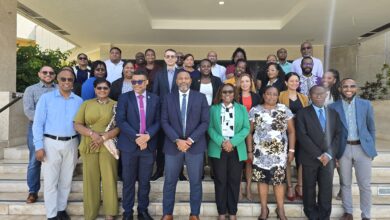|
This Conference is most timely. Its focus on higher education priorities, challenges and opportunities as bridges for strengthening integration between the Caribbean and Latin America, is consistent with the World Conference on Higher Education held in Paris in July 2009; the outcomes of the Fifth Summit of the Americas held in Port- of-Spain, Trinidad and Tobago, April 2009 and the UNESCO Declaration on Educational for All (1990).
The pleasure is however mine to bring you greetings from, and to address you on behalf of, H.E. Edwin Carrington Secretary-General of the Caribbean Community who is unable to be here due to a very demanding schedule. I particularly wish to thank the OAS Department of Human Development, Education and Culture, the UNESCO Cluster Office for the Caribbean and the UNESCO Institute for Higher Education in Latin America and the Caribbean (IESALC) for organising this Caribbean Conference and the Government of Suriname for its gracious hospitality. The letter of invitation to the Secretary-General to give the keynote address listed as one of the desired outcomes, the creation of a higher education Caribbean network of government and university representatives to work closely with the international community to advance the dialogue on higher education and strengthen the cooperation between Latin America and the Caribbean. The Secretary-General has asked me to say to you that the Caribbean Community Secretariat is a willing and enthusiastic partner in this initiative. It is in the spirit of this commitment that I address you on the topic “Regional Integration and Development”. Given the expert presentations listed in your conference programme, I assumed that you require me to put in context the issues that relate to trends in higher education, quality assurance, science and technology, academic cooperation and the development of an agenda for higher education in the Caribbean. Consequently, I will:
Salient Features of the Integration Process Regional integration is about enabling the coherence of a group of Member States to compete more creditably in the globalised economic and political environments and to collectively stem the tide of international and other adversities, especially in these trying times. According to Sir Arthur Lewis [1968] “economic and political integration” has been a perennial and neuralgic issue in the Caribbean agenda: “ the recognition of seminal truth that only a unified Caribbean politically and economically can save the region from fatal particularism is at least a century old”. Seminal truth underscores the philosophy of regionalism in its various manifestations. The short-lived West Indies Federation (1958-1962) was followed by the revival of the integrationist ideal in the less ambitious Caribbean Free Trade Association (1965). Then there is the broadening of the scope of integration through the establishment of the Caribbean Community and Common Market (CARICOM), aimed at formalizing a customs union, foreign policy coordination and functional cooperation as prescribed in the Treaty of Chaguaramas (1973). The inclusion of Suriname in 1995 signalled a move toward cultural diversity, further illustrated by the inclusion of Haiti as a full member of the Community in 2002. Following were the inauguration of the Caribbean Court of Justice in 2005, the initiation of the CARICOM Single Market in 2006 and the ultimate ambitious target set to achieve by 2015 of full mobility of goods, services and people and the harmonisation of economic policies in a CARICOM Single Market and Economy (CSME). The Challenges of the Regional Integration Movement The evaluations of the Caribbean Community are normally cast in the mould of the ultimate ambitious target of a CSME which not even the most acclaimed regional integration movement, the European Community, has achieved. This is mainly due to the fact that the political and economic realities are not fully appreciated based on what gains can be realistically expected from the CSME process and what policies should be explored to minimise these gains. Recent discussions by a Think Tank on A strategic Plan for Regional Development in CARICOM coordinated by Professor Norman Girvan seek to establish the macro-economic context of CARICOM’s development; to review its components with what is called the single development vision for CARICOM; and then to match this approach with national development strategies. Of the 15 Member States in the Community, 12 participate in the CSME process. Overall, there are wide differences among these countries in resource endowments; human capital; economic infrastructure; and institutional capabilities. Their associated export specializations suggest that divergence and differentiation rather than convergence and homogeneity will continue to be the norm in the near future. What is clear is that the traditional gains from regional integration – whether in terms of enlarged market effect or competitive/allocational gains – are bound to be limited because Caribbean economies display a high degree of openness, the enlarged market is relatively small and countries have relatively similar factor endowments. But impediments to an accelerated approach to the CSME are compounded by the failure of the Region to reach agreement on several important prerequisites for a “single economy”. Among them are the establishment of a Monetary Union (not totally achieved by the EU), the adoption of a CARICOM Investment Agreement, the harmonisation of tax policies and provision for fiscal incentives . At the same time, successes have been recorded with respect to the establishment and implementation of the Regional Development Fund (in Barbados), the replacement of the Caribbean Regional Negotiating Machinery with the Office of Trade Negotiations within the Directorate of Trade and Economic Integration of the Caribbean Community Secretariat, and the establishment of the Caribbean Competition Commission (in Suriname). These are all critical to sustaining a level playing field, coordinating trade negotiations and guaranteeing the application of common standards in trade and production in the Community – prerequisites for a sustainable integration process. In addition, many of the activities related to free movement of certain categories of persons – university graduates, cultural workers, teachers, nurses and sports persons are in effect. Other categories –like artisans and domestics with the CARICOM Vocational Qualification (CVQ) have been approved. Yet others, based on contingent rights of spouses and families of “certified” workers, are in the process of being finalised. The basic rationale for CARICOM integration is to overcome the constraints on development specially associated with small size. Hence, the principal aims of integration include:
While the first, normally associated with market integration and common policies, is within the comfort zone of macro economic analysts, “the last three involve functional cooperation in one way or another and therefore constitutes the principal challenge for the policy researcher” . This is the dilemma. At the same time, it provides a useful opportunity to fast track regional integration through functional cooperation. Despite the trade creating reforms of the 1990s and 2000s and the possible determinants of their impacts, there is evidence that the gains have not been significant. At the same time, integration in the area of “non tradables”, i.e., services related to the countries’ social and physical infrastructure (as we will see) have over the years demonstrated substantial successes that are often not recognized by focusing strictly on the outcomes of the CSME. While acknowledging this implementation deficit, most objective analysts agree on the magnitude of the tasks designed to achieve the CSME. In this regard, considerable technical work has been done by the CARICOM Secretariat on the important pillars of the CSME such as development of a CARICOM Investment Code; a CARICOM Financial Services Agreement; proposals for the reform of Community Governance; and the free movement of additional categories of skilled labour. The bottlenecks are by and large due to national resistance, changes in governments and delays in the facilitation of the necessary national regulations or legislation to bring these policies and programmes into effect. In a more profound sense, accelerated approaches are stymied by sustained preoccupation with the notion that CARICOM comprises “sovereign states” which would be eroded by the application of “shared sovereignty”. Writing in a recent issue of the Integrationist , Professor C. Y. Thomas raised the following problematique: “Given the critical juncture at which the Region finds itself, it is not altogether surprising that harsh comments and severe doubts have been expressed in many quarters about the readiness, fitness, seriousness, and even purposefulness of the contemporary leadership elites in moving the Caribbean [forward]” He went on to suggest that: “It is pertinent to this discourse, however, to consider whether these positions are reasonable” and offers the view that “one test of their reasonableness must surely be whether the development record of the Region [does indeed] support such a harsh negative judgment of their stewardship.” Regional Achievements, in Particular the Role of Functional Cooperation as a Critical Lever of Regional Integration It would be difficult for anyone with an objective frame of mind to deny that in general, much economic development has been achieved in the Region. This can readily be seen if we examine the outcomes based on universally accepted indicators of development: income, economic structure, health, education, safety-nets, governance and even perhaps quality of life. The gains have been, undoubtedly, very unevenly distributed, both across and within countries. Also, many gaps and deficits remain, and some of these are huge. Nonetheless, there have been significant development gains to the Region, despite the persistence and harsh setbacks due to the Region’s vulnerability to natural and other disasters. The evidence is there to see in the ratings of CARICOM countries in the Human Development Index, the rates of enrolment in tertiary education and health indicators, especially reductions in infant mortality. Some outstanding examples of development in the Region are illustrated by the following: Based on the world’s most acclaimed development indicators e.g. the UNDP’s (HDI, GEM, GDI, HPI) measures, all the countries, with the exception of Haiti, are classified at a medium level of development or better. Four are classed at a high level of human development.
The Report of the Caribbean Commission on Health and Development chaired by Sir George Alleyne, further states that “health services utilisation, as measured by immunisation coverage, is a success story and that health services coverage in the percentage of pregnant women attended by trained personnel during pregnancy … is virtually 100%” Can these economic, social and political achievements be attributed to the regional integration process? The answer is yes. And the explanation to a large extent is to be found in the application of functional cooperation underpinning the CSME process. We have already alluded to the value of functional cooperation which relates not only to non-tradable goods but is a modality that cuts across trade and economic activity, foreign policy and human and social development, all essential features of the CSME. Functional Cooperation is a cross-cutting element and a driver of regional integration for development. It is a mode of cooperation with rules that encompass or incorporate certain activities carried out specially to support economic, foreign policy and security objectives of the Community. The Report of the Task Force on Functional Cooperation [2008] fully illustrates the strides that have been made through cooperation in all these areas. Among the most celebrated examples of functional cooperation are: The University of the West Indies, established in 1948 as a college of London University and becoming a regional institution in 1962; the Caribbean Examinations Council (CXC) established in 1973; the Caribbean Cooperation in Health Initiative, inaugurated in 1983; the new architecture in crime and security in the post 9-11 era spearheaded by the Council for National Security and Law Enforcement (CONSLE) and the Implementation Agency for Crime and Security (IMPACS); and the critical role being played by the Caribbean Community Climate Change Centre (CCCCC)in helping the Region to marshal its resources to deal with climate change. Then there is the outstanding case of the Pan Caribbean Partnership against HIV/AIDS which has been designated by the UN as an international best practice. The recently established Functional Cooperation Unit in the Office of the Secretary-General has spearheaded a regional work programme for 2010-2011 that highlights functional cooperation priorities in tourism and transportation. This is an interesting development that accords in the first instance with the proposals resulting from the recommendations of the 2008 Ministerial Summit on Regional Tourism. In addition, in the area of foreign policy and diplomacy, the “sovereign states” of the Caribbean Community can identify the value of acting collectively in the negotiating theatres, internationally. These are all indicative of forms of integration that help in no small way to sustain the cohesiveness and viability of the Community in the hemispheric and global systems. Pivotal to the agenda for effective functional cooperation are the regional institutions that formulate regional programmes and policies in a variety of areas, including agriculture, quality and standards, meteorology, disaster management, fisheries management, and the most recently established Caribbean Agriculture Health and Food Safety Authority (CAHFSA) in Suriname. In this regard too, the Caribbean Community annual meeting of approximately 25 regional institutions provides an opportunity for elevating the role of functional cooperation through a formal process of sharing information, reducing duplication, and monitoring and evaluation of the performance of these critical drivers of development. One of the most significant developments in this regard is the recent decision of the CARICOM Heads of Government to establish a Caribbean Public Health Agency (CARPHA) on a phased basis between 2010 and 2014 resulting in the merger of five regional health institutions (CAREC, CEHI, CFNI, CHRC and CRDTL) into one agency. At the same time, the proposed Regional Accreditation Authority, important to the maintenance of education standards throughout the Region, remains outstanding because of a lack of the appropriate number of signatories from Member States to bring it into effect. This demands discussion at this forum. The assistance of Ministers of Education is particularly necessary in bringing this important mechanism into being. Gazing toward an Uncertain Future with Possibilities of strengthening the ties between Latin America and the Caribbean The process of regional integration is now taking on new dimensions as countries reconfigure their priorities and even their loyalties. What is emerging is what Denis Benn refers to as the variable geometry of integration in which countries belong to varying regional groups simultaneously. The OECS provides the most enduring lesson as its over 25-year sub-regional organisation has moved toward achievement of a single economy at a much faster rate than the larger CARICOM Community to which it also belongs. Some CARICOM countries hold membership in ALBA, a grouping of certain South and Central American States led by Venezuela; others in the South American Association led by Brazil to which Guyana and Suriname are members and yet others to the Central American Integration System to which Belize belongs. In addition, there are the Association of Caribbean States (ACS) and the Caribbean Development Cooperation (CDC) to which Member States of CARICOM also belong. Then there is the Declaration resulting from the Mexico Summit in January 2010 to establish a new integration association for Latin America and the Caribbean (LAC). All these point to a need for unraveling the regional maze of institutional affiliation. It is difficult to predict the future. No doubt this forum will discuss those strategies for accelerating higher educational cooperation among and between institutions in LAC. The relevant point in this discussion is that the principles of functional cooperation, if properly applied, allow sovereign states to advance specific programmes in a series of South-South arrangements that contribute significantly to economic development. At the same time, it provides the space for the Region to move toward the refinement and application of CSME requirements that are essentially based on the role and the rule of law that underscore trade and investment policies. The Future of Higher Education in the Scenario of a Variable Geometry Whatever the directions of the integration processes in the future, countries of the Region must deal with the principles and application of an educational strategy that would make their citizens competitive in a world defined by ever-changing priorities. There are so many scenarios that our policymakers could consider as they chart the future of higher education in this changing environment. A few highlights would suffice:
In the final analysis, the future offers overwhelming opportunities through functional cooperation in education.
The future beckons us to a higher level of creativity. Maybe we can continue to demonstrate through functional cooperation in areas like education, how to build a society as the foundation for sustainable economic development. In this way, we can truly achieve regional integration that is meaningful for all. We have an opportunity to transform the current challenges into opportunities to sustain a mature regionalism to which the Rose Hall Declaration on Regional Governance and Integrated Development (2003) refers. This Conference, with its focus on the role of higher education, can help to move the process along in a positive way.
|
|
![]() .
.





